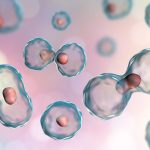The Death Receptor Signaling pathway is a fundamental mechanism in cellular biology, governing programmed cell death or apoptosis. This pathway is pivotal for regulating tissue homeostasis, embryonic development, immune response, and the elimination of damaged or infected cells. It primarily involves the activation of cell surface receptors known as death receptors, which upon ligand binding, trigger a cascade of intracellular events leading to apoptosis. In this narrative, we’ll explore the Death Receptor Signaling pathway in detail, elucidating its components, mechanisms, and physiological significance.
Introduction to Death Receptors
Death receptors are a subclass of cell surface receptors characterized by their ability to induce apoptosis upon ligand binding. They belong to the tumor necrosis factor (TNF) receptor superfamily and play critical roles in immune surveillance and tissue homeostasis. Key death receptors include FAS (also known as CD95 or TNFRSF6), TNF receptor 1 (TNFR1 or CD120a), and TNF-related apoptosis-inducing ligand receptor 1 (TRAIL-R1 or DR4) and receptor 2 (TRAIL-R2 or DR5).
Ligands and Activation
The ligands for death receptors are typically TNF family cytokines, such as FAS ligand (FASL), TNF-alpha (TNF-α), and TNF-related apoptosis-inducing ligand (TRAIL). These ligands are predominantly expressed by activated immune cells and can be released into the extracellular environment upon immune response activation.
Upon binding of the ligand to the extracellular domain of the death receptor, a conformational change occurs, leading to the recruitment and oligomerization of the death receptor in the plasma membrane. This clustering facilitates the recruitment of adaptor proteins and the formation of a signaling complex at the intracellular domain of the receptor, initiating downstream signaling events.
Formation of Death-Inducing Signaling Complex (DISC)
One of the key events in the Death Receptor Signaling pathway is the formation of the Death-Inducing Signaling Complex (DISC). The DISC serves as a platform for initiating intracellular signaling cascades that culminate in apoptosis.
The DISC typically consists of the death receptor, adaptor proteins such as FADD (FAS-associated death domain protein), and initiator caspases, particularly caspase-8 and caspase-10. FADD contains a death domain (DD) that interacts with the DD of death receptors and a death effector domain (DED) that recruits and activates caspase-8 and caspase-10.
Initiator Caspase Activation
Upon recruitment to the DISC, caspase-8 and caspase-10 become activated through induced proximity, where their prodomains undergo self-cleavage, generating active enzyme fragments. These activated caspases then propagate the apoptotic signal by cleaving and activating downstream effector caspases, particularly caspase-3, caspase-6, and caspase-7.
Execution of Apoptosis
The activation of effector caspases initiates a cascade of proteolytic events within the cell, leading to the characteristic morphological and biochemical changes associated with apoptosis. Effector caspases cleave various cellular substrates, including structural proteins, cytoskeletal components, and DNA repair enzymes, ultimately dismantling the cell and leading to its demise.
Regulation of Death Receptor Signaling
The Death Receptor Signaling pathway is tightly regulated to ensure appropriate cellular responses to extracellular stimuli and to prevent excessive or inappropriate apoptosis. Several regulatory mechanisms govern the activation and propagation of the apoptotic signal:
- Caspase Activation and Regulation: Caspase activation is tightly regulated by several factors, including inhibitor of apoptosis proteins (IAPs), which can bind and inhibit activated caspases. Additionally, cellular FLICE-inhibitory protein (c-FLIP) can modulate caspase-8 activation by competing with caspase-8 for binding to FADD at the DISC.
- Feedback Regulation: The Death Receptor Signaling pathway can undergo feedback regulation to modulate its activity. For instance, activated caspase-8 can cleave and activate the pro-apoptotic BH3-only protein Bid, leading to mitochondrial outer membrane permeabilization (MOMP) and amplification of the apoptotic signal through the intrinsic pathway.
- Cellular Context: The cellular context can influence the sensitivity of cells to death receptor-mediated apoptosis. Factors such as the expression levels of death receptors, ligands, and intracellular signaling molecules, as well as the presence of anti-apoptotic proteins, can modulate the cellular response to death receptor activation.
Physiological Significance
The Death Receptor Signaling pathway plays critical roles in various physiological processes, including:
- Immune Response: Death receptor-mediated apoptosis is essential for eliminating activated immune cells, regulating immune homeostasis, and preventing autoimmune diseases. For example, FAS-mediated apoptosis is involved in the deletion of autoreactive T cells during negative selection in the thymus.
- Tissue Homeostasis and Development: Death receptor signaling contributes to tissue remodeling, embryonic development, and organogenesis by eliminating excess or unwanted cells. It also regulates cell proliferation, differentiation, and survival during development.
- Host Defense Against Infection: Death receptor-mediated apoptosis is a crucial mechanism for host defense against pathogens, particularly intracellular pathogens such as viruses. By inducing apoptosis in infected cells, the immune system can eliminate the replicative niche of the pathogen and limit its spread.
Pathological Implications
Dysregulation of the Death Receptor Signaling pathway is implicated in various pathological conditions, including:
- Cancer: Alterations in death receptor expression, ligand availability, or downstream signaling components can promote tumor development and progression by enabling cancer cells to evade apoptosis. Resistance to death receptor-mediated apoptosis is a common mechanism of tumor immune evasion and therapeutic resistance.
- Autoimmune Diseases: Defective death receptor signaling or impaired apoptosis regulation can contribute to the pathogenesis of autoimmune diseases by disrupting immune homeostasis and promoting the survival of autoreactive immune cells.
- Neurological Disorders: Dysregulated death receptor signaling has been implicated in neurodegenerative diseases, such as Alzheimer’s disease and Parkinson’s disease, where excessive apoptosis or impaired apoptotic signaling can contribute to neuronal loss and neuroinflammation.
In summary, the Death Receptor Signaling pathway is a fundamental mechanism for regulating programmed cell death or apoptosis in response to extracellular signals. Through the activation of death receptors and the formation of the DISC, this pathway initiates a cascade of intracellular events culminating in apoptosis. While essential for maintaining tissue homeostasis, embryonic development, and host defense, dysregulation of this pathway is implicated in various pathological conditions, including cancer, autoimmune diseases, and neurological disorders. Understanding the molecular mechanisms and physiological significance of death receptor signaling is crucial for developing therapeutic strategies targeting apoptosis for the treatment of human diseases.

Leave a Reply